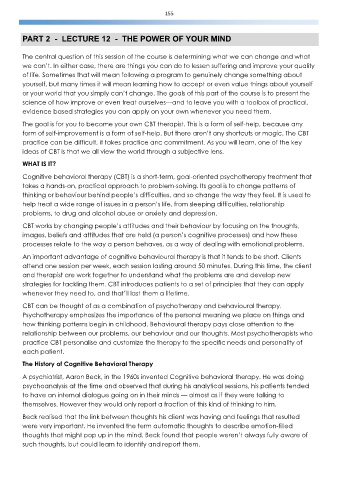Page 155 - C:\Users\STEVEB~1\AppData\Local\Temp\msoF8C5.tmp
P. 155
ϭϱϱ
3$57 - /(&785( - 7+( 32:(5 2) <285 0,1'
The central question of this session of the course is determining what we can change and what
we can’t. In either case, there are things you can do to lessen suffering and improve your quality
of life. Sometimes that will mean following a program to genuinely change something about
yourself, but many times it will mean learning how to accept or even value things about yourself
or your world that you simply can’t change. The goals of this part of the course is to present the
science of how improve or even treat ourselves—and to leave you with a toolbox of practical,
evidence based strategies you can apply on your own whenever you need them.
The goal is for you to become your own CBT therapist. This is a form of self-help, because any
form of self-improvement is a form of self-help. But there aren’t any shortcuts or magic. The CBT
practice can be difficult, it takes practice anc commitment. As you will learn, one of the key
ideas of CBT is that we all view the world through a subjective lens.
WHAT IS IT?
Cognitive behavioral therapy (CBT) is a short-term, goal-oriented psychotherapy treatment that
takes a hands-on, practical approach to problem-solving. Its goal is to change patterns of
thinking or behaviour behind people’s difficulties, and so change the way they feel. It is used to
help treat a wide range of issues in a person’s life, from sleeping difficulties, relationship
problems, to drug and alcohol abuse or anxiety and depression.
CBT works by changing people’s attitudes and their behaviour by focusing on the thoughts,
images, beliefs and attitudes that are held (a person’s cognitive processes) and how these
processes relate to the way a person behaves, as a way of dealing with emotional problems.
An important advantage of cognitive behavioural therapy is that it tends to be short. Clients
attend one session per week, each session lasting around 50 minutes. During this time, the client
and therapist are work together to understand what the problems are and develop new
strategies for tackling them. CBT introduces patients to a set of principles that they can apply
whenever they need to, and that’ll last them a lifetime.
CBT can be thought of as a combination of psychotherapy and behavioural therapy.
Psychotherapy emphasizes the importance of the personal meaning we place on things and
how thinking patterns begin in childhood. Behavioural therapy pays close attention to the
relationship between our problems, our behaviour and our thoughts. Most psychotherapists who
practice CBT personalise and customize the therapy to the specific needs and personality of
each patient.
The History of Cognitive Behavioral Therapy
A psychiatrist, Aaron Beck, in the 1960s invented Cognitive behavioral therapy. He was doing
psychoanalysis at the time and observed that during his analytical sessions, his patients tended
to have an internal dialogue going on in their minds — almost as if they were talking to
themselves. However they would only report a fraction of this kind of thinking to him.
Beck realised that the link between thoughts his client was having and feelings that resulted
were very important. He invented the term automatic thoughts to describe emotion-filled
thoughts that might pop up in the mind. Beck found that people weren’t always fully aware of
such thoughts, but could learn to identify and report them.

